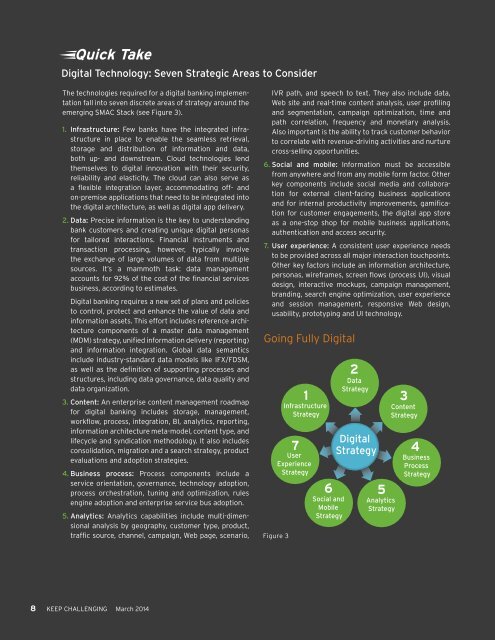Digital-Banking-Enhancing-Customer-Experience-Generating-Long-Term-Loyalty
Digital-Banking-Enhancing-Customer-Experience-Generating-Long-Term-Loyalty
Digital-Banking-Enhancing-Customer-Experience-Generating-Long-Term-Loyalty
Create successful ePaper yourself
Turn your PDF publications into a flip-book with our unique Google optimized e-Paper software.
Quick Take<br />
<strong>Digital</strong> Technology: Seven Strategic Areas to Consider<br />
The technologies required for a digital banking implementation<br />
fall into seven discrete areas of strategy around the<br />
emerging SMAC Stack (see Figure 3).<br />
1. Infrastructure: Few banks have the integrated infrastructure<br />
in place to enable the seamless retrieval,<br />
storage and distribution of information and data,<br />
both up- and downstream. Cloud technologies lend<br />
themselves to digital innovation with their security,<br />
reliability and elasticity. The cloud can also serve as<br />
a flexible integration layer, accommodating off- and<br />
on-premise applications that need to be integrated into<br />
the digital architecture, as well as digital app delivery.<br />
2. Data: Precise information is the key to understanding<br />
bank customers and creating unique digital personas<br />
for tailored interactions. Financial instruments and<br />
transaction processing, however, typically involve<br />
the exchange of large volumes of data from multiple<br />
sources. It’s a mammoth task: data management<br />
accounts for 92% of the cost of the financial services<br />
business, according to estimates.<br />
<strong>Digital</strong> banking requires a new set of plans and policies<br />
to control, protect and enhance the value of data and<br />
information assets. This effort includes reference architecture<br />
components of a master data management<br />
(MDM) strategy, unified information delivery (reporting)<br />
and information integration. Global data semantics<br />
include industry-standard data models like IFX/FDSM,<br />
as well as the definition of supporting processes and<br />
structures, including data governance, data quality and<br />
data organization.<br />
3. Content: An enterprise content management roadmap<br />
for digital banking includes storage, management,<br />
workflow, process, integration, BI, analytics, reporting,<br />
information architecture meta-model, content type, and<br />
lifecycle and syndication methodology. It also includes<br />
consolidation, migration and a search strategy, product<br />
evaluations and adoption strategies.<br />
4. Business process: Process components include a<br />
service orientation, governance, technology adoption,<br />
process orchestration, tuning and optimization, rules<br />
engine adoption and enterprise service bus adoption.<br />
5. Analytics: Analytics capabilities include multi-dimensional<br />
analysis by geography, customer type, product,<br />
traffic source, channel, campaign, Web page, scenario,<br />
IVR path, and speech to text. They also include data,<br />
Web site and real-time content analysis, user profiling<br />
and segmentation, campaign optimization, time and<br />
path correlation, frequency and monetary analysis.<br />
Also important is the ability to track customer behavior<br />
to correlate with revenue-driving activities and nurture<br />
cross-selling opportunities.<br />
6. Social and mobile: Information must be accessible<br />
from anywhere and from any mobile form factor. Other<br />
key components include social media and collaboration<br />
for external client-facing business applications<br />
and for internal productivity improvements, gamification<br />
for customer engagements, the digital app store<br />
as a one-stop shop for mobile business applications,<br />
authentication and access security.<br />
7. User experience: A consistent user experience needs<br />
to be provided across all major interaction touchpoints.<br />
Other key factors include an information architecture,<br />
personas, wireframes, screen flows (process UI), visual<br />
design, interactive mockups, campaign management,<br />
branding, search engine optimization, user experience<br />
and session management, responsive Web design,<br />
usability, prototyping and UI technology.<br />
Going Fully <strong>Digital</strong><br />
Figure 3<br />
Infrastructure<br />
Strategy<br />
7<br />
1<br />
User<br />
<strong>Experience</strong><br />
Strategy<br />
6<br />
Social and<br />
Mobile<br />
Strategy<br />
2<br />
Data<br />
Strategy<br />
<strong>Digital</strong><br />
Strategy<br />
5<br />
Analytics<br />
Strategy<br />
3<br />
Content<br />
Strategy<br />
4<br />
Business<br />
Process<br />
Strategy<br />
8 KEEP CHALLENGING March 2014




